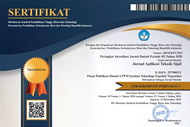Analisis Faktor Yang Mempengaruhi Penerapan Implementasi Pengolahan Limbah Konstruksi Berkelanjutan Pada Proyek Konstruksi Gedung Bertingkat
Abstract
Keywords
Full Text:
PDFReferences
N. Han, H. Tomonori, I. Rieko, K. Masato, and Y. Ken, “A review of construction and demolition waste management in Southeast Asia,” J. Mater. Cycles Waste Manag., vol. 22, no. 2, pp. 315–325, 2020, doi: 10.1007/s10163-019-00914-5.
A. Akhtar and A. K. Sarmah, “Construction and demolition waste generation and properties of recycled aggregate concrete: A global perspective,” J. Clean. Prod., 2018, doi: 10.1016/j.jclepro.2018.03.085.
H. Wu, J. Zuo, H. Yuan, G. Zillante, and J. Wang, “Resources , Conservation & Recycling A review of performance assessment methods for construction and demolition waste management,” Resour. Conserv. Recycl., vol. 150, no. June, p. 104407, 2019, doi: 10.1016/j.resconrec.2019.104407.
A. Khoshand and K. Khanlari, “Construction and demolition waste management : Fuzzy Analytic Hierarchy Construction and demolition waste management : Fuzzy Analytic Hierarchy Process approach,” no. March, 2020, doi: 10.1177/0734242X20910468.
F. Zhang, Y. Ju, E. D. R. Santibanez, A. Wang, and P. Dong, “Evaluation of construction and demolition waste utilization schemes under uncertain environment : A fuzzy heterogeneous multi-criteria decision-making approach,” J. Clean. Prod., vol. 313, no. June, p. 127907, 2021, doi: 10.1016/j.jclepro.2021.127907.
B. Cheng, J. Huang, Z. Guo, J. Li, and H. Chen, “Towards sustainable construction through better construction and demolition waste management practices : a SWOT analysis of Suzhou , China,” Int. J. Constr. Manag., vol. 0, no. 0, pp. 1–11, 2022, doi: 10.1080/15623599.2022.2081406.
H. Fitriani and S. Ajayi, “Analysis of the Underlying Causes of Waste Generation in Indonesia ’ s Construction Industry,” pp. 1–18, 2025.
M. R. Esa, A. Halog, and L. Rigamonti, “Strategies for minimizing construction and demolition wastes in Malaysia,” "Resources, Conserv. Recycl., 2016, doi: 10.1016/j.resconrec.2016.12.014.
R. Merino, P. I. Gracia, I. Salto, and W. Azevedo, “Waste Management & Research,” no. September 2009, 2010, doi: 10.1177/0734242X09103841.
A. J. Morrissey and J. Browne, “Waste management models and their application to sustainable waste management,” vol. 24, pp. 297–308, 2004, doi: 10.1016/j.wasman.2003.09.005.
M. M. M. Teo and M. Loosemore, “A theory of waste behaviour in the construction industry A theory of waste behaviour in the construction industry,” no. September 2013, pp. 37–41, 2010, doi: 10.1080/01446190110067037.
D. Almira, “Bangunan Paket Keahlian Batu Dan Beton Di Jawa Timur,” 2015.
U. A. Umar, N. Shafiq, and F. A. Ahmad, “Civil Engineering A case study on the effective implementation of the reuse and recycling of construction & demolition waste management practices in Malaysia,” Ain Shams Eng. J., vol. 12, no. 1, pp. 283–291, 2021, doi: 10.1016/j.asej.2020.07.005.
N. I. Blaisi, “Construction and demolition waste management in Saudi Arabia : Current practice and roadmap for sustainable management,” J. Clean. Prod., vol. 221, pp. 167–175, 2019, doi: 10.1016/j.jclepro.2019.02.264.
Y. Su, J. Chen, H. Si, G. Wu, R. Zhang, and W. Lei, “Decision-making interaction among stakeholders regarding construction and demolition waste recycling under different power structures,” Waste Manag., vol. 131, no. June, pp. 491–502, 2021, doi: 10.1016/j.wasman.2021.06.025.
M. Eghbali-zarch and R. Tavakkoli-moghaddam, “Prioritizing the effective strategies for construction and demolition waste management using fuzzy IDOCRIW and WASPAS methods,” vol. 29, no. 3, pp. 1109–1138, 2022, doi: 10.1108/ECAM-08-2020-0617.
H. Ghailani et al., “lP pro of Jou rna,” Appl. Soft Comput., p. 110606, 2023, doi: 10.1016/j.asoc.2023.110606.
A. Mahpour, “Resources , Conservation & Recycling Prioritizing barriers to adopt circular economy in construction and demolition waste management,” Resour. Conserv. Recycl., vol. 134, no. December 2017, pp. 216–227, 2018, doi: 10.1016/j.resconrec.2018.01.026.
A. Al-otaibi et al., “Identifying the Barriers to Sustainable Management of Construction and Demolition Waste in Developed and Developing Countries,” pp. 1–17, 2022.
Y. Ali, Z. Aslam, H. Sajid, and D. Ubaidullah, “A multi ‑ criteria decision analysis of solid waste treatment options in Pakistan : Lahore City — a case in point,” Environ. Syst. Decis., 2018, doi: 10.1007/s10669-018-9672-y.
P. Rani, A. Raj, R. Krishankumar, and K. S. Ravichandran, “Multi-criteria food waste treatment method selection using single-valued neutrosophic-Critic-Multimoora framework,” Appl. Soft Comput., vol. 111, p. 107657, 2021, doi: 10.1016/j.asoc.2021.107657.
H. Y. Yap and J. D. Nixon, “A multi-criteria analysis of options for energy recovery from municipal solid waste in India and the UK,” WASTE Manag., 2015, doi: 10.1016/j.wasman.2015.08.002.
C. Estay-ossandon, A. Mena-nieto, and N. Harsch, “Using a fuzzy TOPSIS-based scenario analysis to improve municipal solid waste planning and forecasting : A case study of Canary archipelago ( 1999 e 2030 ),” J. Clean. Prod., vol. 176, pp. 1198–1212, 2018, doi: 10.1016/j.jclepro.2017.10.324.
L. Zhu, J. Dai, G. Bai, and F. Zhang, “Study on thermal properties of recycled aggregate concrete and recycled concrete blocks,” Constr. Build. Mater., vol. 94, pp. 620–628, 2015, doi: 10.1016/j.conbuildmat.2015.07.058.
M. Ma, V. W. Y. Tam, K. N. Le, and W. Li, “Challenges in current construction and demolition waste recycling : A China study,” Waste Manag., vol. 118, pp. 610–625, 2020, doi: 10.1016/j.wasman.2020.09.030.
G. Borghi, S. Pantini, and L. Rigamonti, “Life cycle assessment of non-hazardous Construction and Demolition Waste ( CDW ) management in Lombardy Region ( Italy ),” J. Clean. Prod., vol. 184, pp. 815–825, 2018, doi: 10.1016/j.jclepro.2018.02.287.
H. O. Onubi, N. A. Yusof, and A. S. Hassan, “How environmental performance in fl uence client satisfaction on projects that adopt green construction practices : The role of economic performance and client types,” J. Clean. Prod., vol. 272, p. 122763, 2020, doi: 10.1016/j.jclepro.2020.122763.
T. Wang, Z. Wu, and C. Luo, “Resources , Conservation & Recycling Multi-participant construction waste demolition and transportation decision-making system,” Resour. Conserv. Recycl., vol. 170, no. December 2020, p. 105575, 2021, doi: 10.1016/j.resconrec.2021.105575.
L. Kong and B. Ma, “Environmental Technology & Innovation Evaluation of environmental impact of construction waste disposal based on fuzzy set analysis,” Environ. Technol. Innov., vol. 19, p. 100877, 2020, doi: 10.1016/j.eti.2020.100877.
S. Iodice, E. Garbarino, M. Cerreta, and D. Tonini, “Sustainability assessment of Construction and Demolition Waste management applied to an Italian case,” Waste Manag., vol. 128, no. 2021, pp. 83–98, 2024, doi: 10.1016/j.wasman.2021.04.031.
J. Flannery, S. O. Ajayi, and A. S. Oyegoke, “Alcohol and Substance Misuse in the Construction Industry,” vol. 3548, 2019, doi: 10.1080/10803548.2019.1601376.
E. Ewan et al., “Review Article Is Adversity Quotient ( Aq ) Able To Predict The Academic Performance Of Polytechnic Students ?,” vol. 7, no. 3, pp. 393–398, 2020.
A. G. Yong and S. Pearce, “A Beginner ’ s Guide to Factor Analysis : Focusing on Exploratory Factor Analysis,” vol. 9, no. 2, pp. 79–94, 2013.
T. O. Miranti, S. Nugroho, and E. Sunandi, “Mempengaruhi Minat Konsumen Dalam Berbelanja ( Studi Kasus : Bencoolen Mall ).”
DOI: http://dx.doi.org/10.12962%2Fj2579-891X.v22i3.20835
Refbacks
- There are currently no refbacks.

Jurnal Aplikasi Teknik Sipil by Pusat Publikasi Ilmiah LPPM Institut Teknologi Sepuluh Nopember is licensed under a Creative Commons Attribution-ShareAlike 4.0 International License
Based on work at https://iptek.its.ac.id/index.php/jats




